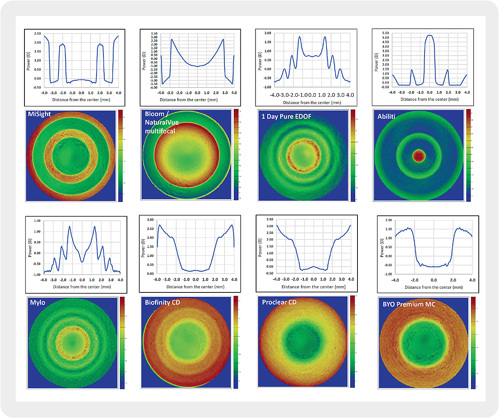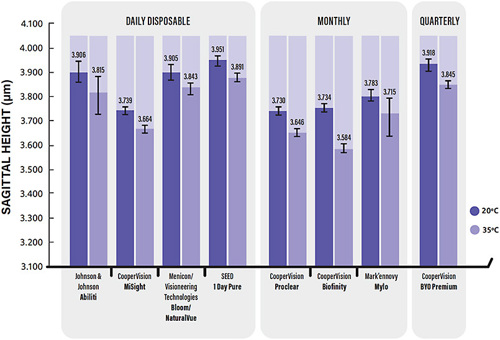
MANY EYECARE PRACTITIONERS (ECPs) use soft contact lenses as one of the options with the intention being to reduce myopia progression in children. But what do we know about the power profiles of these lenses?

Are there any differences, or are they all the same? What about the lens fit characteristics and the modalities of these lenses? Some are available with toric options; some are daily disposables; some are molded lenses; and others are lathe-cut. Let’s dive slightly deeper into available lenses for myopia management, some of which are used worldwide as “off-label” options, while some are approved for myopia management.1
LENS DESIGNS
Soft contact lenses designed for myopia management induce myopic defocus2 or simultaneous competitive myopic defocus3 on the peripheral retina as a mechanism to reduce myopia progression while maintaining acceptable visual performance for distance.4 The efficacy of these designs is related to their optical profiles,5 the amount of peripheral defocus induced,6 and the correct position of the lens optics (e.g., lens centration).7
Lens fit and efficacy of the myopia management outcome go hand in hand. In addition, it is unclear at this point what it means if a “flat” or a “steep” lens is applied to a standard eye—let alone to an eye that is not standard in shape—and what this does to the optics of the lens.
In this article, we report the differences in the power profiles and in posterior sagittal heights (sag) of the most common soft lenses used for myopia control to give ECPs potentially more insight into what they are fitting children with in daily practice. These observations were originally presented as a poster at the 2023 Global Specialty Lens Symposium (GSLS) that won first prize in the research category of this year’s poster contest.1
OPTIONS
For contact lens practitioners, it is very helpful to have different lens options in terms of optics and lens fit, as no two eyes are the same. In the soft-lenses-for-myopia arena, three lens modalities are available: daily disposables, monthly replacement, and quarterly replacement. As noted, certainly not all of these lenses are approved for—or labelled as—myopia management lenses, but they may all be used as such in different parts of the world.
The lenses available in the daily disposable category are MiSight (CooperVision) and the NaturalVue multifocal (Visioneering Technologies), which is also marketed as Bloom Day (Menicon) in other parts of the world. In addition, there is 1dayPure (SEED), a lens with a progressive optical profile (not marketed for myopia management), and the Abiliti (Johnson & Johnson), which has a torus design.
In the monthly replacement category are lenses such as Biofinity and Proclear Multifocal (both by CooperVision), which are molded lenses that can be ordered in toric prescriptions as well. The Mylo (Mark’ennovy) is another monthly replacement lens specially designed for myopia management and also available as a toric lens. This lens is lathe cut; typically lathe-cut lenses are somewhat thicker than molded lenses, although the differences are not as large as one might expect.8 Lathe-cut lens manufacturing does open an entire range of new possibilities for custom-made (front- and back-surface) options.
As a third group, quarterly replacement lenses are available from a large variety of lens manufacturers around the world, including the BYO Premium MC lens (CooperVision). All are lathe-cut lenses, with the added benefit that these lenses are available in a wide variety of diameters, base curves, and powers (including variable add powers). Some of these lenses can even be manufactured with custom optic zone diameter sizes. The downside of quarterly replacement lenses is that extra care and attention to hygiene and safety are required, especially given that, for myopia management, these lenses are used by young children.
OBSERVATION
Eight different soft contact lenses indicated for myopia control (on-label and off-label for that indication) were imaged (Table 1). Three of each of these eight lenses were stored in standard saline solution for 24 hours prior to measurement following International Organization for Standardization (ISO) 18369-39 recommendations. The optical radial power profiles were measured with an optical lens analyzer, using a wet cell with saline solution at 20°C.
To obtain the measurement of the sag of the lenses, a spectral domain optical coherence tomography (SD-OCT)-based lens analyzer was used. The measurements were obtained after the lenses were allowed to equilibrate for approximately 20 minutes at both 20°C (room temperature and ISO standard) and 35°C (eye temperature) using an instrument that controlled temperature and filtration. Each lens was measured three times; average values were reported at each temperature.
POWER PROFILES
Figure 1 shows the power profiles of the eight lenses analyzed, and the data show interesting characteristics. First, the optical profiles vary substantially among the different designs.

From an educational standpoint, we divided the eight lenses analyzed into four primary profile categories: multiconcentric, multifocal, extended depth of focus (EDOF), and torus. The multiconcentric category has sharp power changes in three rings of power surrounding the central distance zone. The “classic” multifocal design has a center-distance (CD) zone.The EDOF design has either catenary optics designed with a power change that can be pictured as the U-like shape, or non-monotonic/aperiodic optics designed without discrete power zones and in which the power varied above and below the normal mean power. Finally, the “torus” design has a non-coaxial peripheral toroidal ring of positive power.
When looking at an optical zone diameter of 8mm for these lenses, the difference between the minimum and maximum powers within one lens design was noted to be quite substantial, with the highest difference (> 5.00D) occurring in the Bloom/NaturalVue multifocal and Abiliti and the lowest difference (2.00D) occurring in the BYO Premium MC lens. Of the eight lenses analyzed, the MiSight, Proclear CD, Biofinity CD, and BYO MC designs all have a central zone with a constant distance power over a diameter between 2.8mm and 4.0mm; the other lens designs show a gradual power profile in the lens center.
LENS FIT
The lenses tested showed considerable differences in sag values (Figure 2), although not as much as one might expect given the differences in lens diameter (range between 13.8mm and 14.5mm) and base curve radius (range between 7.9mm and 8.6mm). Measurements at 20°C revealed that the highest sag value (steepest) was the 1dayPure EDOF, and the lowest (flattest) was the Proclear CD (a difference in sag of 221μm).

As reported previously, base curve radius again proves to not be a good predictor of overall lens shape.10 The lens with the steepest base curve (7.9mm), a daily disposable, was not substantially different from the other lenses in that category that have much flatter base curves. Daily disposable lenses were slightly higher in sag compared to monthly lenses (172μm on average).
The temperature of 20°C is the standard (ISO required) temperature to measure and label soft contact lenses. However, when the lens goes on the eye, the temperature difference changes some of the lens parameters; in general, lenses shrink on the eye when going from room temperature to eye temperature (at 35°C).11 At this higher temperature, all of the lenses in our study showed a reduced sag compared with their sag at 20°C; the highest absolute value now was the 1dayPure EDOF lens, and the lowest was the Biofinity CD (Δsag 307μm).
This means that there are differences between lenses that could potentially influence lens fit, particularly lens centration. This also means, from a research perspective, that the temperature change when a lens goes on the eye needs to be investigated in more detail to more fully understand on-eye lens behavior and the practical consequences of that.
POSSIBLE CLINICAL APPLICATIONS
In summary, from a practical standpoint, when looking at different lenses for myopia management (on- and off-label), two primary observations stand out. First, different optical profiles can induce different myopia progression optical effects on-eye. ECPs may choose one of the four principal categories over another when changing lens design (multiconcentric, multifocal, EDOF, and torus). If a lens in a certain soft lens category does not provide satisfactory myopia management results, switching to another category makes more sense as a theoretical consideration than trying another lens in the same category, but this certainly needs to be proven in clinical trials.
Second, there are differences in sag values between lenses, which can induce a different interaction with the anterior segment and possibly have an effect on lens centration and optics. A complicating factor in this may be that differences between measurements at 20°C and at 35°C can be substantial, which must be looked at in more depth.
However, based on these observations, it appears that for a more effective myopia control treatment with soft contact lenses in the future, ECPs may be advised to perform additional measurements, such as pupil diameter, ocular sagittal height, and ocular aberrations, to more accurately select which contact lens design would be most effective. CLS
References
- Montani G, Van der Worp E. Power profile and sagittal height differences of soft contact lenses indicated for myopia control. Poster presented at 2023 Global Specialty Lens Symposium, Las Vegas. January 2023.
- González-Méijome JM, Peixoto-de-Matos SC, Faria-Ribeiro M, et al. Strategies to Regulate Myopia Progression With Contact Lenses: A Review. Eye Contact Lens. 2016 Jan;42:24-34.
- Smith EL III, Arumugam B, Hung L-F, She Z, Beach K, Sankaridurg P. Eccentricity-dependent effects of simultaneous competing defocus on emmetropization in infant rhesus monkeys. Vision Res. 2020 Dec;177:32-40.
- Li Q, Fang F. Advances and challenges of soft contact lens design for myopia control. Appl Opt. 2019 Mar 1;58:1639-1656.
- Wildsoet CF, Chia A, Cho P, et al. IMI – Interventions Myopia Institute: Interventions for Controlling Myopia Onset and Progression Report. Invest Ophthalmol Vis Sci. 2019 Feb 28;60:M106-M131.
- Yu Z, Zhong A, Zhao X, Li D, Duan J. Efficacy and safety of different add power soft contact lenses on myopia progression in children: a systematic review and meta-analysis. Ophthalmic Res. 2022;65(4):398-416.
- Fedtke C, Ehrmann K, Thomas V, Bakaraju RC. Association between multifocal soft contact lens decentration and visual performance. Clin Optom (Auckl). 2016 Jun 28;28;8:57-69.
- Contact Lens Compendium. Available at compendium.contactlensupdate.com/us. Accessed March 15, 2023.
- ISO. ISO 18369-3:2017 Ophthalmic optics—Contact lenses—Part 3: Measurement methods. 2017 Aug.
- Van der Worp E, Lampa M, Kinoshita B, Fujimoto MJ, Coldrick BJ, Caroline P. Variation in sag values in daily disposable, reusable and toric soft contact lenses. Cont Lens Anterior Eye. 2021 Dec;44:101386.
- Young G, Potts M, Sulley A. The effect of temperature on soft contact lens diameter. Eye Contact Lens. 2016 Sep;42:298-302.



